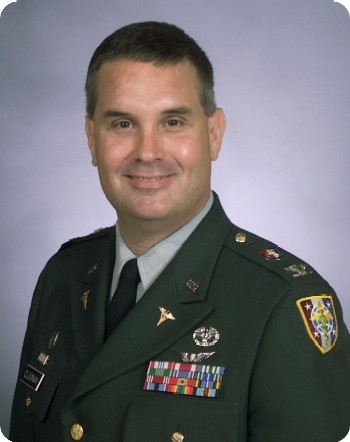|
Clifford C. Cloonan, M.D., FACEP
Colonel (ret) Medical Corps
United States Army
Serving 30 years in the US Army, Colonel Cloonan is
among the most knowledgeable of military physicians in immediate care.
He has served as:
-
Infantryman
-
Special Forces Medic
-
Flight Surgeon
-
Division Surgeon
-
Chief of Emergency Medicine
-
Dean of the Joint Special Operations Medical
Training Center
-
Interim Chairman of the Department of Military and
Emergency Medicine at the Uniformed Services University
-
Consultant to the Surgeon General for Emergency
Medicine
Dr. Cloonan has observed that:
-
The simple answer is the right answer.
-
Well-performed basic techniques are usually better
for the patient than more complicated techniques.
-
Conscious inaction is better than mindless action.
-
Training is more important than equipment.
-
when a procedure is taught, particularly one that
seems "heroic" (e.g. cardiac massage), that the procedure will be
performed much more often than indicated.
-
If you are looking for the solution to a problem the
first place to look is in the past because there is a good chance
that someone else either already solved the same or a similar
problem or at least was able to find out what didnít work.
Continue...
|

This definitive text describes the history of wounding, mechanisms
of injury, historical missteps, and current treatments for injuries
sustained in military and operational settings. It is a culmination of
his knowledge, accumulated through first-hand experience and a
lifetime dedicated to the study of these issues. This is must-read
material for those medical personnel working with the wounded within
minutes of injury, and those who train these front-line Medics,
Hospital Corpsmen and EMTs.
TABLE OF CONTENTS
Introductory Thoughts
- Introduction
- Acknowledgements
- About the Author
Airway
- Introduction
- History of Airway Management
- Frequency of Airway Obstruction in
Civilian Populations
- Frequency of Airway Obstruction in
Combat
- Indications for Airway Management at
Point of Wounding
- Prophylactic Airway Management
- Responsibility for Airway
- Management at Point of Wounding
- Decision Making in Airway Management
- The Technical Imperative
- Airway Management Proce3dures
- Basic Airway Management
- Body Position
- Advanced Airway Management
- References
Breathing
- History and Epidemiology of Thoracic Injury
and Respiratory Impairment in Combat Casualties
- Epidemiology of Civilian Thoracic Trauma
- Physiology and Pathophysiology of
Ventilation, Oxygenation, and Respiration in Combat Casualties
- High Altitude (environmental) Hypoxia
- Hypoventilation
- Ventilation - Perfusion (V/Q) Mismatch
- Anemic Hypoxia
- Circulatory (stagnant) Hypoxia
- Histiocytic Hypoxia
- General Approach to the management of a
Combat Casualty with Possible Impairment of Ventilation,
Oxygenation, and/or Respiration
- Initial Assessment and Management of the
Thoracic Wounded Casualty
- History
- Physical Examination
- Auscultation
- Use of ultrasonography to detect lung injury
- Pulse Oximetry
- Pre-Hospital Assessment of Thoraco-Abdominal
Injury
- Assessment of Shock in Thoracic Wounded
Casualties
- General Management of Thoracic Wounded
Casualties
- Oxygenation and Ventilation of Thoracic
Wounded Casualties
- Specific Mechanisms of Combat-related Injury
Associated with Impairment of Ventilation, Oxygenation, and/or
Respiration and their Management
- thoracoabdominal and Diaphragmatic Injury
- Penetrating Chest Trauma
- Blast Lung
- Circumferential Burns of the Chest Wall
- Triage and Evacuation of Casualties with
Oxygenation and Ventilation Problems.
Circulation
- Hemorrhagic Shock
- Types of Shock
- Stages of Shock
- Compensated Shock
- Decompensated Shock
- Irreversible Shock
- Individual Manifestations of Shock
- Identifying the patient in Hemorrhagic Shock
at or near the Point of Wounding.
- Specific Tests for Shock
- Fluid Resuscitation
- Non-blood fluids
- Transfusion near the Point of Wounding
- Blood substitutes
- Pneumatic Antishock Garment
- Hemorrhage Control
- Other Types of Shock
Disability
- Overview and Epidemiology of Head and Spine
Injury
- Head Injury
- Neck Injury
- Injuries Involving the Spinal Cord
- Civilian vs. Military Spine Injuries
- Definition of Instability
- Influence of Mechanism of Injury on Spine
Instability
- Frequency of Spinal Cord Injury and
Instability in Penetrating Trauma
- Diagnosis
- Clearing the Cervical Spine at or near the
Point of Wounding
- Probability of Spine Injury in Patients with
other Injuries above the Clavicle
- Clinical Findings in Cervical Spine Injury
- Spine Injury Treatment
- Care of the Casualty with Head Trauma
|
